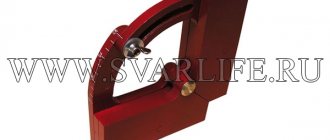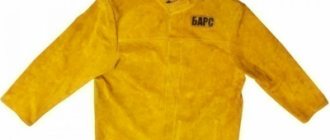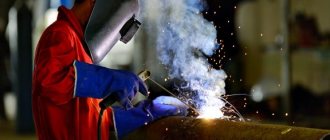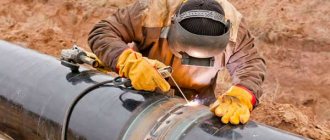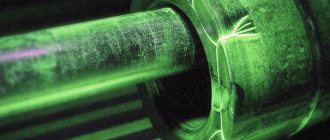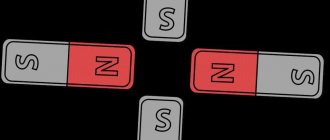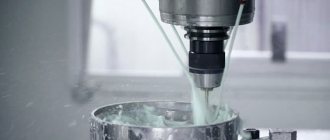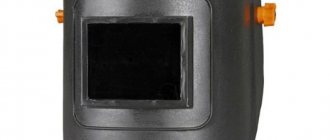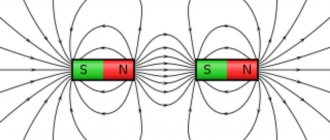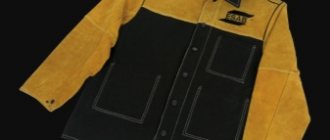Welding work requires maximum precision. It is convenient to secure structural elements in a certain position using a magnetic welding square. Manufacturers make magnetic fixtures for welders of various designs. They come with permanent and switchable magnets and differ in the load they can withstand.
Magnetic corners for welding
For welding work, magnetic holders with a certain size of corners are used. They produce universal designs with regulators; they secure the support bars to any angle. For home welding, craftsmen make their own compact squares from scrap materials.
What is a magnetic square and what is it for?
With its help, you can connect the metal sheets to be welded and hold them in this position until the welding is completed.
The square allows you to set the parts at the desired angle. If there must be a gap of a certain width between the parts, the square will cope with this task. This auxiliary element consists of two halves of a non-magnetic body, between which a powerful magnet is laid. A powerful permanent magnet or a switchable electromagnet can be used as a source of magnetic field.
Unlike clamps and other devices in which fixation is carried out using threaded clamps, a magnetic square holds parts in a given position using a magnetic field. This solution makes the square a more durable device, since its design has no moving parts, as well as threaded connections prone to breakage. Therefore, the square can last longer than a device with threaded clamps under equal operating conditions. In addition, installing angles saves the welder time, because now there is no need to tighten the clamps for a long time.
A magnetic square is, in fact, a welder’s “third hand”. It allows you to do without the help of a partner who will hold the structures being connected.
What to look for when choosing magnetic welding angles
When selecting magnetic angles, you should remember the following important points:
- The power of the welding magnet must correspond to the mass of the elements being welded. A low-power magnet cannot effectively hold massive parts.
- The most popular are triangular devices. The angles 45°, 90° and 135° incorporated in them are the most used in practice.
- Switchable type devices are more convenient when working.
As we have already said, magnetic angles can be purchased at a very affordable price, for example, on AliExpress
What types of angles are there?
Depending on the design and functionality, angles can be divided into several subgroups:
- Simple clamps built on the basis of permanent magnets. These are the cheapest magnetic clamps available on the domestic market, however, working with them is not always convenient.
- Detachable latches. They have a switch that allows you to turn off the magnetic field. After disconnecting, you can detach the latch from the metal, rather than tearing it off by applying powerful force. The most convenient devices of this class are those with switches located on both sides.
- Magnetic clamps. These devices will allow you to adjust the strength of magnetic attraction and the angle that can be set. The most advanced and expensive devices of this class allow you to install the parts to be connected in any position in three planes. However, the cost of such devices is very high, so they already belong to the professional class.
In addition to the above, we can mention homemade magnetic squares. It's not very difficult to make. In addition, such a device can set any angle, unlike store clamps, which set only fixed angles.
You can make a magnetic square with your own hands. How it's done
You can make a simple magnetic square with your own hands using a magnet found in some old household appliance (radio, TV).
Having decided to make a square, for example, arrow-shaped, it is necessary to cut 2 elements from sheet steel of any grade, the configuration of which is shown in the figure below. Particular attention should be paid to the accuracy of the corner dimensions.
An insert is installed between the metal parts, providing additional structural rigidity and protecting the magnet from the adhesion of metal debris. Any material such as plywood can be used for its manufacture. A cradle for the magnet is cut out in the center of the insert. The dimensions of this element should be such that it is slightly smaller than the metal plates. This way it will not interfere with welding.
What signs should a high-quality square have?
Today, there are many models of welding angles on sale. It's quite difficult to choose between them. However, if you follow a few simple tips, you can find a quality square for little money.
Here are a few rules to follow when choosing a square:
- Never skimp on magnet power. A low-power square may turn out to be cheaper, but during operation it will only cause inconvenience if it falls off the parts being connected at the most inopportune moment. Most experts agree that the square should hold at least 20 kg of lift.
- If money allows, it is worth buying a switchable angle. It is much easier to remove after finishing work, which saves the welder’s time and effort. To disconnect the square, simply flip the switch. It is especially convenient to use squares with switches located on both sides. After turning off the magnet, the square can be easily cleaned of adhering metal dust.
- It is better if the product is designed to accommodate not just one angle, but several. Most modern angles allow you to set five or six different angles.
- Before purchasing, you should check how firmly the chosen square can hold the connected parts. Profiles secured with a square should not move from their place even after an attempt to move them with powerful muscular effort.
- It's a question of price. It is clear that a high-quality tool cannot be too cheap. A decent quality square suitable for household work can cost between 300-500 rubles. However, it is better to take several pieces at once. If you take magnetic devices for professional work, the cost can fluctuate around 3 thousand rubles and more. An example of a good quality square sold at an affordable price is the magnetic locking fixtures developed by Smart Solid.
How to choose a magnetic corner
First, determine the purposes for which the holder is purchased. If you need it for home welding, it is better to purchase a simple monolithic magnetic corner for welding, with one angle of mating parts. Its cost ranges from 500 rubles.
For permanent welding work, choose universal models with several adjustable mates, which have three or four edges. They come in various shapes and sizes, their cost depends on the holding power of the magnet, reaching 1000 rubles. The clamps are made from heat-resistant alloys; they last a long time and are convenient to use. It is important to pay attention to the quality of materials, because the corner is located in the heating zone of the metal, and due to the high temperature, the holding force of the magnet weakens.
Professionals choose holders with an adjustable angle between the slats. The advantages of such a tool are that a magnetic clamp is capable of tightly fixing rolled pipe in any plane.
Magnetic clamp
The holding device is selected based on the weight of the parts and the complexity of the connection, so workshops purchase several simple and universal holders at once. When purchasing them, they check how quickly and easily it comes off the metal.
When choosing switchable latches, choose devices made of chrome; they are reliable and can withstand heavy weight. They are suitable for riding work, parts of the structure are held securely, you can loosen your hands when working. The cost of devices with switchable strips reaches 2 thousand rubles.
The corner should be easy to attach, securely fixed to the metal, and quickly removed. Only in this case will the device be used frequently. The corner will ensure safe work for the welder and will facilitate the process of precise mating of parts.
What rules must be followed when using a square?
Before you start using a square, you should carefully remember the rules for safe work with this tool and always adhere to them in your work.
Firstly, it is worth considering the weight that the square can hold and not exceed it. A part that comes off at the most unexpected moment can cause defects or cause injury. So make sure the magnet is powerful enough to hold it. The most powerful magnets for holding heavy parts can withstand loads of up to 34 kg! Fixed parts should not wobble when force is applied to them.
Secondly, it is worth remembering that when heated from welding, the metal is deformed. Therefore, there is an additional load on the square, which may exceed the ability of the square to hold parts. To avoid unexpected drop of the square and divergence of the seam, before starting to weld the seam, tack the parts at several points on both sides of the installed magnetic clamp. After this, the metal will no longer diverge from thermal deformation after welding the main seam.
The third rule is due to the fact that the magnetic field from a strong magnet can deflect the electric arc to the side. Therefore, do not forget to remove the angles from their installation sites when approaching them. The process of removing and installing the square can be facilitated by the use of switchable magnetic clamps.
Do not neglect these simple rules, and working with a magnetic square will always be easy and safe for you.
Magnetic squares Smart Solid: the choice of professionals
The Smart Solid company produces several model lines of magnetic fasteners. Here are several models from this manufacturer that are in greatest demand in our country.
- MAG 613/614/615 . _ _ _ The clamps of this series are built on the basis of permanent magnets. 30°, 45°, 60°, 75°, 90°, 135° - angles that can be set using angles from this model range. The three models differ only in size and the weight they can hold. All angles in this series use powerful ferrite alloy magnets. The magnetic square of the 615th model (the highest model in the line) can withstand weight up to 34 kg!
- MAG601 / MAG602 / MAG603 is another model series that differs only in size and power. The set angles are the same in all models of the series and are 45°, 90°, 135°. Ferrite non-switchable magnets can hold weight from 11 kg for the younger model to 34 kg for the older one. In this range, you can choose a device suitable for any job.
- MAG 610 is not one square, but a set of four magnetic clamps of the same shape. 45°, 90°, 135° - angles that can be set using these squares. Each of them can withstand up to 4 kg of load, but thanks to the distribution of force between the four fixing elements, the set can hold parts with much larger weights. Flat profile, pipes, strips, metal profiles - the square holds parts of various shapes equally well. The magnets used in the design of the product are non-switchable and made of ferrite.
- MAG 605/606 is a series of switchable magnetic clamps designed for setting angles of 45°, 90°, 135°. As in other series, the magnetic latches have the same shape and angles. Thanks to the ability to turn off, the magnet is convenient to remove and replace. You can cope with this task even with one hand! The older model in the series is capable of handling a load of 24 kg.
So, magnetic angles from Smart Solid are a useful tool that can significantly facilitate a welder’s work. When used correctly, they can allow small-scale welding work to be carried out quickly and efficiently. Several squares of different designs will successfully complement the arsenal and will help in work activities, both for a professional welder and for a beginner who is just beginning to master this skill.
What advantages do magnetic angles provide?
Any additional devices that make the master’s work easier have positive aspects of use. A magnetic corner for welding is an indispensable attribute even for a one-time need, not to mention in-line work performed by professionals:
- due to the fact that the metal parts intended for welding are securely fixed, the welder receives greater freedom of action and, therefore, ease of operation;
- due to the fact that the assembly of the welded elements is carried out before the actual welding, one person is enough to complete it - magnetic corners minimize labor costs;
- when using a magnetic welding angle, the parts are installed accurately, and therefore the completed seam will be neat: when carrying out welding work on high-precision structures, angles are not a recommendation, but a necessity;
- when performing a large volume of welding work, such corners are simply irreplaceable - they will significantly reduce the time spent by a specialist on welding;
- for parts of non-standard configuration it is also convenient to use magnetic welding corners;
- parts to be welded can be securely fixed not only on a horizontal, but also on a vertical surface;
- In addition to welding, soldering and other types of work connecting individual elements, magnetic corners will be convenient, for example, when marking or cutting steel - a strong fixation will keep individual parts of the structure from falling.
As a rule, angles from well-known manufacturers have a configuration that allows using one such magnetic clamp to set different welding angles: 45°, 60°, 90°, 135°. A self-made magnetic corner makes it possible to work with almost any angle set to the tool profile.
